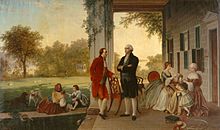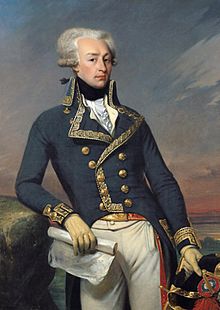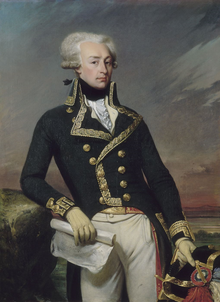Marie-Joseph Motier, Marquis de La Fayette
Marie-Joseph-Paul-Yves-Roch-Gilbert du Motier, Marquis de La Fayette or Lafayette (born September 6, 1757 in Chavaniac (now Chavaniac-Lafayette ), France, † May 20, 1834 in Paris ) was a French Général de division and politicians. The Enlightenment took part in the American Revolutionary War on the colonist side and played an important role in the French Revolution .
life and work
origin
La Fayette came from an old noble family from the Auvergne , whose members had often embarked on a military career. One of his relatives, Gilbert Motier de La Fayette , was Marshal of France in the 15th century . His father was Michel Louis Christophe Roch Gilbert Paulette du Motier, Marquis de La Fayette (1732-1759), Colonel of the Grenadiers de France . He was killed at the age of 26 in the Seven Years' War in Westphalia when a bullet hit him on August 1, 1759 in the Battle of Minden . He died in the arms of Duke Victor-François de Broglie .
His mother, Marie Louise Jolie de La Rivière (1737–1770), a wealthy aristocrat from Saint-Brieuc, led a secluded life in the Palais du Luxembourg in Paris until she died on April 3, 1770. The Marquis de La Fayette was orphaned at the age of 12 and the potential sole heir of the considerable fortune of his maternal grandfather, the Marquis de La Rivière, who died on April 24, 1770 and left him a pension of 25,000 livres . At the same time, through the death of another uncle, he inherited an annual income of 120,000 livres. He became one of the richest men in France of his time. It was his great-grandfather, the Count de La Rivière, a former high officer in the royal army, who had him educated in Paris.
Education and marriage
La Fayette studied at the Collège du Plessis , today's Lycée Louis-le-Grand , until 1771 , and at the same time trained as an officer candidate in the regiment of the King's Black Musketeers . The Duke of Broglie, the friend of the late father, had made him decide to pursue a military career and join the royal guard . Accordingly, he also graduated from the Versailles Military Academy .
On April 11, 1774, at the age of 17, he married Marie Adrienne Françoise de Noailles (1759-1807), the daughter of the Duke of Ayen, Paul-François de Noailles . She brought a dowry of 200,000 livres into the marriage. His parents-in-law, from one of the oldest families at the French court and also related to Madame de Maintenon , introduced the La Fayettes to court in the spring of 1774. The marriage resulted in a son and three daughters:
- Adrienne Henriette Catherine Charlotte du Motier (1776–1778)
- Anastasie Louise Pauline Motier du Motier (1777–1863), who married Jules César Charles de Fay, Count of La Tour Maubourg (1774–1824) on February 23, 1798 . Through her, the Marquis is an ancestor of Paola Ruffo di Calabrias , the former Queen of Belgium, wife of King Albert II.
- Georges Washington Louis Gilbert du Motier, Marquis of Lafayette (1779–1849), who married Émilie d'Estutt de Tracy .
- Marie Antoinette Virginie du Motier (1782-1849), who married Louis de Lasteyrie du Saillant, Marquis of Lasteyrie (1781-1826) on April 20, 1803 .
At the court of Louis XVI. La Fayette couldn't do anything. Since he was more attached to his own freedoms and had no sense of the courtly spirit, all attempts by his father-in-law to get him a favorable position at court were unsuccessful. After his marriage, he voluntarily left the court to join his father-in-law's Regiment de Noailles dragons , after being promoted to captain of the Dragoons. The Duke de Broglie became its commandant
In the American War of Independence
From 1771 to 1776 La Fayette served in the French army, but soon he resigned. After the declaration of independence of the British colonies in 1776, La Fayette went to America against the massive resistance of his family with a self-recruited volunteer group to fight for American independence and its ideals of equality, freedom and justice associated with the Enlightenment . On June 13, he landed north of Charleston and offered his unpaid services to the Continental Army . On July 31, by a special resolution of the Congress , he was appointed major general of the Continental Army.

As a staunch democrat and enlightened advocate of the idea of freedom, La Fayette campaigned for democracy, the abolition of slavery and human rights , which Thomas Jefferson wrote in Virginia in 1776 . During this time he was admitted to a military Masonic lodge in Morristown in the presence of George Washington . La Fayette later became a member of the Contrat Social Masonic lodge in France and the Les Neuf Sœurs Masonic lodge in Paris .
In 1778 France and the USA allied against Great Britain , whereupon Great Britain declared war on France. La Fayette returned to France for six months in 1779 to raise military and financial resources for the United States. In 1780 he returned to America on board the Hermione and was a leader in the Virginia campaign. This ended in 1781 with the surrender of the British at Yorktown . On December 18, 1781, La Fayette returned from Boston to France.
In the United States, he was celebrated as a great war hero. Several cities and counties were named after him (mostly with the spelling Lafayette ), e.g. B. in Louisiana, Mississippi and Indiana. In 1785 he was elected to the American Academy of Arts and Sciences .
Return to France
When La Fayette arrived in France in January 1782, the people gave him a triumphant welcome. He was received in Versailles on January 22nd. Louis XVI accepted him into the assembly of notables . The Catholic La Fayette, who had come to know and appreciate George Washington and other Protestants in the United States, got in touch with two Reformed pastors, Paul Rabaut and his son Jean-Paul Rabaut Saint-Étienne . Under La Fayette's influence, Louis XVI. In November 1787 the Edict of Tolerance at Versailles , which benefited the Huguenots in particular , who were last subjected to severe persecution again from 1743 to 1752.
French Revolution

La Fayette was the main link between the American Revolution and the French Revolution . An avid supporter of American constitutional principles, he called on all states to follow the American example. La Fayette was a leading politician in the early stages of the French Revolution. Through membership in his Masonic lodges, he also became a member of the Society of Thirty . In 1789 he became a member of the Estates General . On July 11, 1789, he introduced to the new National Assembly a draft declaration of human and civil rights based on the American model, which he had drawn up with the support of Thomas Jefferson , one of the authors of the United States' Declaration of Independence and then Ambassador to Paris .
On July 14, 1789 he became Vice President of the National Assembly. After the storming of the Bastille on July 14, 1789, he became commander of the National Guard and founded the politically moderate club of the Feuillants , who strove for a constitutional monarchy based on the English model. During the October Riots he threw down the Republicans under Danton to protect the royal family . On July 14, 1790, when the federation festival was celebrated on the Field of Mars, La Fayette was the first to take the civic oath.
La Fayette was held responsible for the fact that the king was able to attempt an escape on June 20, 1791 . Three days after the 2nd anniversary of the storm on the Bastille, he opened fire on an angry crowd. This massacre on the Field of Mars with dozens of dead cost him a large part of his popularity. On October 1, after the dissolution of the National Assembly, he resigned the leadership of the National Guard, whereupon the King gave him command of one of the three French armies.
In 1792 La Fayette commanded the " Armée du Center " in the war between France and Austria . But after the Tuileries storm on August 10th and the king was imprisoned, La Fayette protested firmly. Thereupon he was publicly accused by the Jacobins of wanting to stand in the way of their goals and turn the troops against them. The National Assembly declared him a traitor. La Fayette therefore fled to Flanders , where he was captured by the Austrians. In 1792 he was interned by the Prussians in their fortress Wesel and in Magdeburg and from 1794 by Austria in Olomouc , Moravia . It was only Napoleon Bonaparte who obtained his release in 1797. He traveled to Hamburg, where he lived temporarily, and left it again in early 1799.
During the revolution, La Fayette's wife Adrienne had to watch the execution of her grandmother, mother and sister by the revolutionaries and narrowly escaped the guillotine herself .
After the revolution
On returning to France, La Fayette retired to his Lagrange estate and stayed away from public life because he rejected Bonaparte's policies.
After Napoleon's exile, he became involved in politics again. La Fayette was a member of the Chamber of Deputies from 1815, from 1818 to 1824 and from 1825 until his death . Since 1818 he was a Liberal MP. During the July Revolution of 1830 , he again commanded the National Guard and supported the accession of the "citizen king" Louis Philippe . Both in the post-Napoleonic Restoration and after the July Revolution, La Fayette led the upper-class opposition.
La Fayette died in Paris on May 20, 1834 at the age of 76 and was buried in the Cimetière de Picpus cemetery.
Honors

His name is entered on the triumphal arch in Paris in the 3rd column.
For his services in the American Revolutionary War, the state of Maryland made the Marquis de La Fayette (and all his male descendants for all time) a citizen on December 28, 1784 , which subsequently made him a US citizen after the adoption of the United States Constitution. Citizen made. He also received honorary citizenship of Connecticut, Massachusetts and Virginia. On August 6, 2002, Congress also made him an honorary citizen of the United States of America .
In the US cities have ( Lafayette , Fayette , or Fayetteville ), 17 counties ( Fayette County , Lafayette County ), townships ( Fayette Township , Lafayette Township ), dioceses ( Bishopric Lafayette , Diocese of Lafayette in Indiana ), the Lafayette Cemetery in New Orleans the Fayette Historic State Park , Mount Lafayette and Lake Lafayette and much more in honor of his name.
In the House of Representatives Chamber in Washington, DC , La Fayette is shown in one of the two portraits posted there (the other shows George Washington ). He is also said to have brought the custom of setting up trees of freedom from America to France.
The United States Navy named the submarine USS Lafayette (SSBN-616) after the Marquis, which is the lead ship of the Lafayette-class . The French Navy has named the frigate F-710, the lead ship of the La Fayette class , after him.
On May 27, 2010 the asteroid (23244) Lafayette was named after him.
Quotes
“The origin of all sovereignty lies with the nation. No corporation, no individual can exercise an authority that has not been expressly delegated by it. "
"Rebellion is the most sacred of all rights and the most necessary of all duties."
Movies
- The young general (Original title: La Fayette ) (1961), directed by Jean Dréville ; War film, adventure film and biography, La Fayette is played by Michel Le Royer
- The French Revolution (1989), directed by Robert Enrico and Richard T. Heffron ; as a two-part historical drama conceived monumental feature film , La Fayette is by Sam Neill played
- La Fayette, the faded hero , documentary by Oren Jacoby (2010), et al. a. with Sarah Vowell , aired December 4, 2010 on Arte
literature
- Andreas Latzko : Lafayette . Rascher, Stuttgart 1935.
- Alfons Galette : General Lafayette in Wittmoldt. A life for freedom. Sönksen, Plön 1989, ISBN 3-927875-21-X .
English
- La Fayette: The letters of Lafayette to Washington. 1777-1799 (= Memoirs of the American Philosophical Society. Vol. 115, ISSN 0065-9738 ). 2nd printing. Edited and revised by Louis Gottschalk and Shirley A. Bill. American Philosophical Society, Philadelphia PA 1976.
- Peter Buckman: Lafayette. A biography. Paddington Press, New York NY et al. 1977, ISBN 0-448-22060-1 .
- Harlow Giles Unger: Lafayette. Wiley, Hoboken 2002, ISBN 0-471-39432-7 .
- Edmond Charles Clinton Genet: An American for Lafayette. The diaries of ECC Genet. Lafayette Escadrille. Edited by Walt Brown with an introduction by Dale L. Walker. University Press of Virginia, Charlottesville VA 1981.
- Louis Gottschalk (Ed.): Lafayette. A guide to the letters, documents, and manuscripts in the United States. Cornell University Press, Ithaca NY 1975, ISBN 0-8014-0953-5 .
- Louis Gottschalk: Lafayette comes to America. Chicago University Press, Chicago IL 1935 (2nd impression, with corrections. Ibid. 1965).
- Stuart W. Jackson (Ed.): LaFayette. A bibliography (= Burt Franklin bibliography and reference Series. Vol. 196). Franklin, New York NY 1968.
- Marian Klamkin: The return of Lafayette, 1824-1825. Scribner, New York NY 1975.
- Sylvia Neely: Lafayette and the Liberal ideal 1814-1824. Politics and conspiracy in an age of reaction. Southern Illinois University Press, Carbondale IL 1991, ISBN 0-8093-1733-8 .
- Lloyd Kramer: Lafayette in Two Worlds. Public Cultures and Personal Identities in an Age of Revolution . Univ. of North Carolina Press, Chapel Hill 1996, ISBN 0-8078-2258-2 .
- Paul S. Spalding: Lafayette. Prisoner of State. University of South Carolina Press, Columbia 2010, ISBN 978-1-57003-911-9 .
French
- Jacques Debû-Bridel: La Fayette. Une vie au service de la liberté. del Duca, Paris 1957.
- René de La Croix de Castries: LaFayette. Tallandier, Paris 1981, ISBN 2-235-01081-4 .
- Etienne Taillemite: LaFayette. Fayard, Paris 1989, ISBN 2-213-02340-9 .
Web links
- The Lafayette Collection ( Cornell University , Ithaca , New York )
- "Freedom hero and traitor loyal to the king" (Calendar sheet of Deutschlandradio from September 6, 2007 - broadcast manuscript)
- Works by and about Marie-Joseph Motier, Marquis de La Fayette in the German Digital Library
Individual evidence
- ↑ Eugen Lennhoff, Oskar Posner, Dieter A. Binder: Internationales Freemaurerlexikon . Revised and expanded new edition of the 1932 edition, Munich 2003, 951 pages, ISBN 3-7766-2161-3
- ↑ Alexander Giese : The Freemasons. An introduction. 2nd, unchanged edition. Böhlau, Vienna et al. 1997, ISBN 3-205-98598-2 .
- ^ R. Voeltzel: France. Church history . Religion Past and Present , 3rd Edition, Volume II, Column 1039
- ↑ Karl Heussi : Kompendium der Kirchengeschichte , 11th edition, Tübingen (1957), p. 428
- ↑ Johann Anselm Steiger, Sandra Richter (Ed.): Hamburg. A metropolitan region between early modern times and the Enlightenment (= Metropolis . Texts and studies on centers of culture in modern European times), Berlin: Akademie Verlag 2012, XII + 924 pp., ISBN 978-3-05-005784-2 , pp. 355ff .
- ↑ Charles Curry Aiken, Joseph Nathan Kane: The American Counties: Origins of County Names, Dates of Creation, Area, and Population Data, 1950-2010 . 6th edition. Scarecrow Press, Lanham 2013, ISBN 978-0-8108-8762-6 , p. Xiv.
| personal data | |
|---|---|
| SURNAME | La Fayette, Marie-Joseph Motier, Marquis de |
| ALTERNATIVE NAMES | Lafayette |
| BRIEF DESCRIPTION | French general and politician |
| DATE OF BIRTH | September 6, 1757 |
| PLACE OF BIRTH | Chavaniac , France |
| DATE OF DEATH | May 20, 1834 |
| Place of death | Paris |




